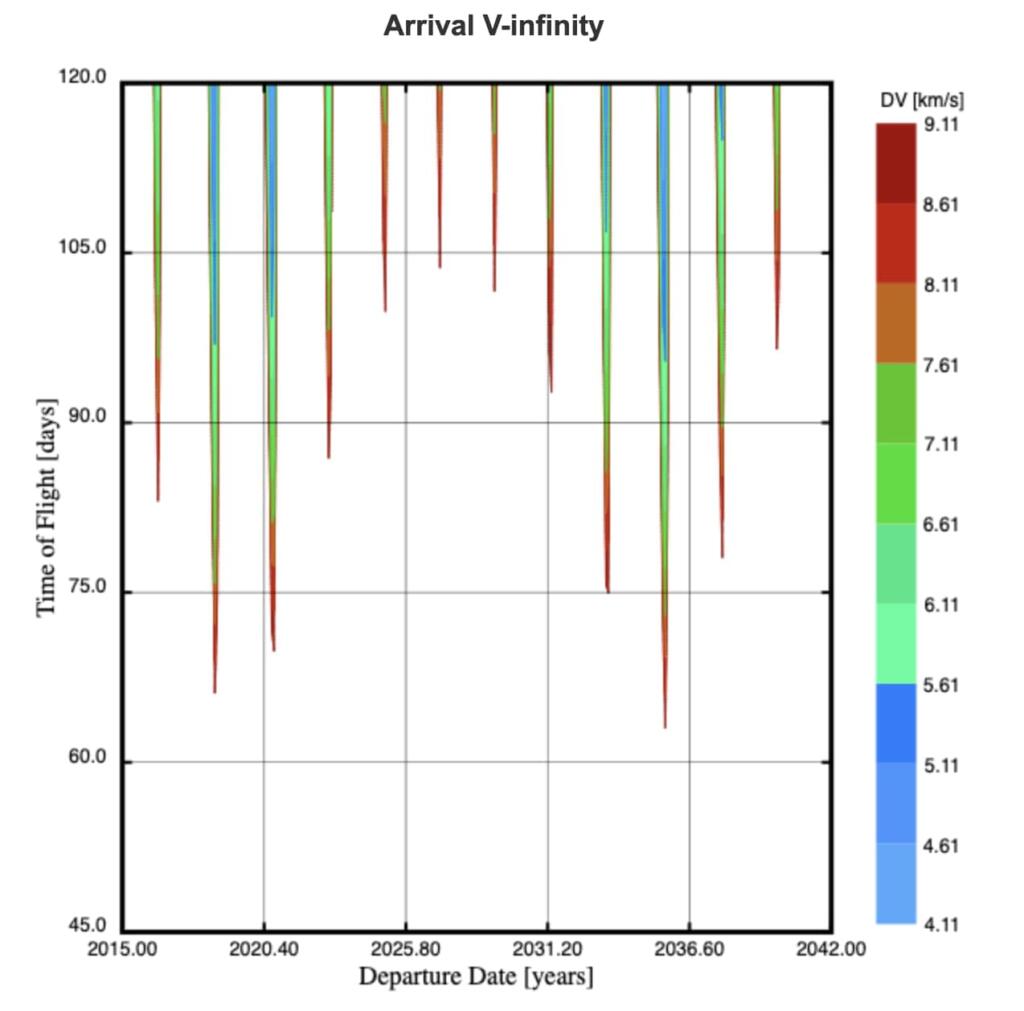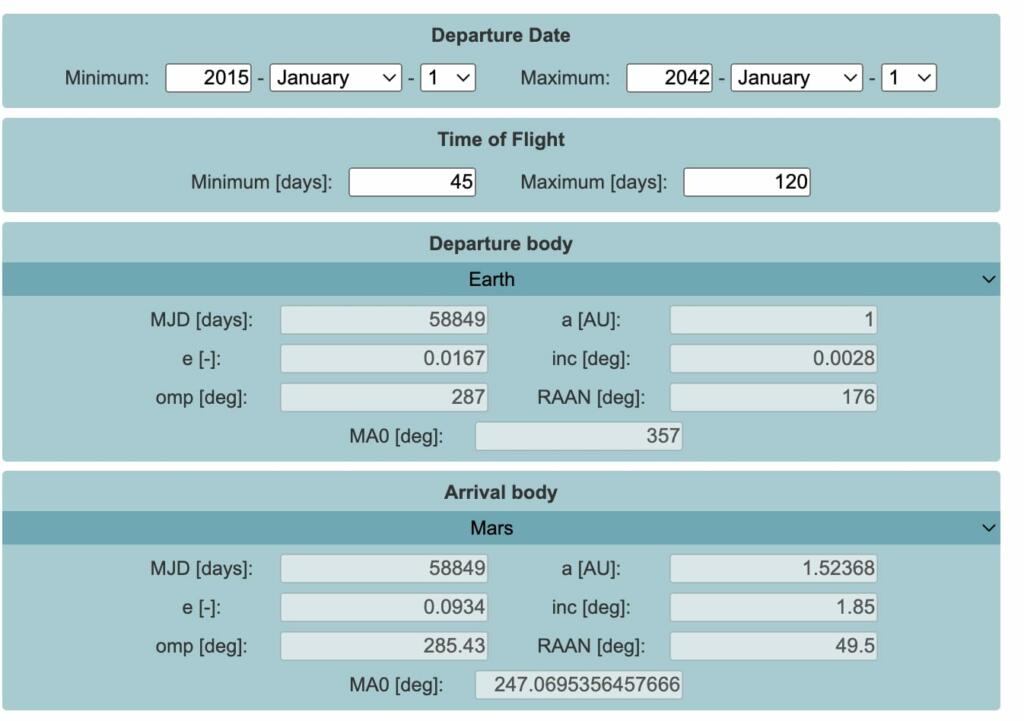We can calculate the travel times for the SpaceX Starship to reach Mars. It is relatively easy to get 90 day trips each way with SpaceX Starship. This is faster than the usual 180-270 one-way travel times. This can be faster because we will have a lot more fuel to enable more direct routes to Mars. We could catch up Mars in 1/6th of an orbit instead of half of an orbit around the Sun.
There are ways to use extra expandable Starship tankers that fly with the main Starship and then transfer the extra fuel for deceleration from higher speed.
If there is more things built and working in orbit around the Earth, then this can be used to enable more ways to save fuel for faster or bigger missions. This can be done with reusable tugs to move a fully fueled Mars bound ship to higher orbits or even to escape velocity.
There is online calculator for the Lambert’s Targeting Problem (LTP) to produce launch and arrival v-infinity pork-chop plots between solar system targets selected by the user.
Scott Manley explains how these calculations work.
In terms of drastically reducing the time in days to get from Earth to Mars then it helps a lot to be able to go faster. The SpaceX Starship can enable a lot of extra fuel and more powerful chemical engines. Extra fuel can come from orbital refueling of the Starship. Other spacecraft and the Starship might only have 10% of the starting fuel because they used most of it getting to orbit.
The performance of the SpaceX Raptor engines is already very good but SpaceX is working on better engines. LEET 1337 will have even higher chamber pressure which will enable more thrust. The SpaceX LEET 1337 engines will be simpler, lighter and cheaper. SpaceX will likely be able to build them at ten times the production volume from the same sized factory that will now make 4000 Raptor engines each year.
SpaceX is also developing improvements to Starship that could enable larger fuel tanks.
The travel time and fuel calculations are from a low earth orbit refueling location. This assumption and situation could be changed IF there was a reusable tug that moved the SpaceX Mars ship to near Earth escape velocity. This would let the Mars bound Starship get to a higher speed without using on board fuel. This would save fuel for deceleration and landing.
A lot of refueling and creating a reusable tug are things that can be done when the cost of ships and fuel to orbit are very low. SpaceX and Elon want to get the cost of fully reusable Starship down to less than $10 million for the upper stage. The mass produced rocket engines are targeting $250,000 each while the older Shuttle era RS25 engines cost about $100 million each. The methane fuel can be made from abundant natural gas or can be made in large quantities using solar power and factories using materials in Earth and Mars atmosphere.
The main game changers are the making the ship and engines 100 to 1000 times cheaper and fully reusable. Things that would be wasteful or too costly become affordable.



There is more fuel that is needed to slowdown once a ship gets to Mars. There are ways to use the Martian atmosphere to aerobrake to land on Mars using no fuel. There is a maximum speed for aerobraking to work.




Background
The solution method is based on the works:
Approximate Analytical Solution of the Lambert’s Targeting Problem. Claudio Bombardelli, Juan Luis Gonzalo, Javier Roa. In Journal of Guidance, Control and Dynamics, Volume 41, Issue 3, 2018, pp. 792-801. https://doi.org/10.2514/1.G002887.
Approximate Analytical Solution of the Lambert’s Targeting Problem. Claudio Bombardelli, Javier Roa, Juan Luis Gonzalo. Paper AAS 16-212 in 26th AAS/AIAA Space Flight Mechanics Meeting, Napa, CA, USA, 14-18 February 2016.
Solar system bodies move on Keplerian orbits (all perturbations are neglected) and transfer arcs are Keplerian.
There are errors of up to 15-20% because it is computation of very inefficient transfer arcs (i.e. far from minimum delta-V conditions).

Brian Wang is a Futurist Thought Leader and a popular Science blogger with 1 million readers per month. His blog Nextbigfuture.com is ranked #1 Science News Blog. It covers many disruptive technology and trends including Space, Robotics, Artificial Intelligence, Medicine, Anti-aging Biotechnology, and Nanotechnology.
Known for identifying cutting edge technologies, he is currently a Co-Founder of a startup and fundraiser for high potential early-stage companies. He is the Head of Research for Allocations for deep technology investments and an Angel Investor at Space Angels.
A frequent speaker at corporations, he has been a TEDx speaker, a Singularity University speaker and guest at numerous interviews for radio and podcasts. He is open to public speaking and advising engagements.


NASA/DoD need to fund development of inflatables, external ECLSS, along with tugs. Why?
This would allow switching in/out items, as price/ tech/needs changes. There is only so far that chemical engines can go. We need to replace chemical engines with nuclear for moving around in space. Being able to simply build them and attach to working cargo/ manned systems makes good sense.
Likewise, making ECLSS units as external means being able to have 2-4/module for use in travel between earth/mars, as opposed to needing 1-2 for earth/moon, and 1 for LEO station.
I wonder, will it be docking at a space station with an observation deck. So many mishaps will avoided by observing and seeding the planet with fauna. Something like Gene Rodenberry’s Deep Space Nine.
Talking about Starship does the Mars run is a bir premature when only one has landed successfully – and even that was on fire !